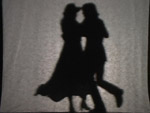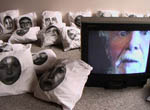Ludmila Belova. Save As… (video installation, objects).
 Catalogue. Co-organized with Anna Akhmatova Museum (Fontanny Dom). St. Petersburg. Russia. Digital archives seem to be the best way of preserving national heritage. International museum world has been obsessed with the idea of transferring museum exhibits into digital format lately. The original is too fragile and unreliable, while in the digital database it becomes virtually everlasting. But then it is a difficult choice, what should and what should not be saved. The museum is usually expected to show the world in logical order; so for hundreds of years, museum workers have been sorting pieces of information, separating the most important facts from less important and occasional. As a rule, all such classifications are too straightforward.
Catalogue. Co-organized with Anna Akhmatova Museum (Fontanny Dom). St. Petersburg. Russia. Digital archives seem to be the best way of preserving national heritage. International museum world has been obsessed with the idea of transferring museum exhibits into digital format lately. The original is too fragile and unreliable, while in the digital database it becomes virtually everlasting. But then it is a difficult choice, what should and what should not be saved. The museum is usually expected to show the world in logical order; so for hundreds of years, museum workers have been sorting pieces of information, separating the most important facts from less important and occasional. As a rule, all such classifications are too straightforward.  The small details of everyday life, its sounds and scents escape from these classifications, going away together with the time they belong to. At the same time, by collecting and preserving this “not so important” information, recording bits of talks and sounds of the street, we can create an archive of personal life, where memory, individual and subjective by nature, is opposed to objective and collective history. In the project “Save As” time is saved not in chronological order, but rather as pieces of information on a hard disk, where different files and directories can be opened at the same time. At the entrance to the gallery, the camera films the visitors and, with the use of a special filter, the image is projected put to the screen, where contours of any person present can be drawn by a visitor. In the 18th century, a candle and a transparent screen were used for this purpose. In the modern version of this game they were replaced by a camera and a projector, but the aim remains the same- to preserve an image, to “remember” it. The video-camera films the present moment, but by the use of the filter the image is made old, as if it were from the past. The installation in the next room reflects the real past. Television sets and pillows scattered on the floor suggest a sort of “home-screening”. Black-and-white images from old passport photos are printed on the pillows instead of patterns. As opposed to real people shown on the TV screens, the faces on the photos are anonymous and deprived of personal features. Enlarged and given an oval shape, they become so generalized that they look familiar. The lives of all the characters telling their stories are connected with the apartments at 34, Fontanka embankment, or house 51, Liteiny Prospect. This type of interview, known as “oral history”, is generally used to reconstruct a recent event or to write the history of a certain local community. In the stories told by “Akhmatova’s neighbors”, the History is left behind. Most of the interviewees refuse to talk about World War II and the Siege of Leningrad, they share memories music they danced to and films they saw, but hardly remember the dates and the sequence of political events. The main character of all the stories is not the history but the memory, fixing the smallest details, that turn out to be the most important parts of life. While the video stories preserve personal reminiscences, the sound-installation saves “audio-memory”. Incidental street noises, overheard conversations, the ringing of mobile phonos, dialogues in the fleamarket are all interwoven with old melodies- the markers of time- – are mixed in the soundtrack, composed by Alexei Rakhov specially for the project. The music is based on sounds of different times and origins. The soundtrack exists as a separate music piece (recorded on the disk at the end of the catalogue), and as an audio part of the video installation, where the dancing couple is travelling from one time to another and where waltz, tango and foxtrot are mixed with contemporary music. The screen, resembling a sheet hanged out to dry, conceals the dancers’ bodies, leaving only two shadows moving slowly and constantly. The most “material” objects in this media-space are old earthenware plates with calligraphic signs promising that “summer is coming soon…”, “spring is coming soon…”, “winter is coming soon…”These reflect our expectations. The word “soon” corresponds to the future, and our perception of time turns into hope, so that it is not so important any more that everything that was promised has already happened and will happen again, like spring, summer and autumn.
The small details of everyday life, its sounds and scents escape from these classifications, going away together with the time they belong to. At the same time, by collecting and preserving this “not so important” information, recording bits of talks and sounds of the street, we can create an archive of personal life, where memory, individual and subjective by nature, is opposed to objective and collective history. In the project “Save As” time is saved not in chronological order, but rather as pieces of information on a hard disk, where different files and directories can be opened at the same time. At the entrance to the gallery, the camera films the visitors and, with the use of a special filter, the image is projected put to the screen, where contours of any person present can be drawn by a visitor. In the 18th century, a candle and a transparent screen were used for this purpose. In the modern version of this game they were replaced by a camera and a projector, but the aim remains the same- to preserve an image, to “remember” it. The video-camera films the present moment, but by the use of the filter the image is made old, as if it were from the past. The installation in the next room reflects the real past. Television sets and pillows scattered on the floor suggest a sort of “home-screening”. Black-and-white images from old passport photos are printed on the pillows instead of patterns. As opposed to real people shown on the TV screens, the faces on the photos are anonymous and deprived of personal features. Enlarged and given an oval shape, they become so generalized that they look familiar. The lives of all the characters telling their stories are connected with the apartments at 34, Fontanka embankment, or house 51, Liteiny Prospect. This type of interview, known as “oral history”, is generally used to reconstruct a recent event or to write the history of a certain local community. In the stories told by “Akhmatova’s neighbors”, the History is left behind. Most of the interviewees refuse to talk about World War II and the Siege of Leningrad, they share memories music they danced to and films they saw, but hardly remember the dates and the sequence of political events. The main character of all the stories is not the history but the memory, fixing the smallest details, that turn out to be the most important parts of life. While the video stories preserve personal reminiscences, the sound-installation saves “audio-memory”. Incidental street noises, overheard conversations, the ringing of mobile phonos, dialogues in the fleamarket are all interwoven with old melodies- the markers of time- – are mixed in the soundtrack, composed by Alexei Rakhov specially for the project. The music is based on sounds of different times and origins. The soundtrack exists as a separate music piece (recorded on the disk at the end of the catalogue), and as an audio part of the video installation, where the dancing couple is travelling from one time to another and where waltz, tango and foxtrot are mixed with contemporary music. The screen, resembling a sheet hanged out to dry, conceals the dancers’ bodies, leaving only two shadows moving slowly and constantly. The most “material” objects in this media-space are old earthenware plates with calligraphic signs promising that “summer is coming soon…”, “spring is coming soon…”, “winter is coming soon…”These reflect our expectations. The word “soon” corresponds to the future, and our perception of time turns into hope, so that it is not so important any more that everything that was promised has already happened and will happen again, like spring, summer and autumn.